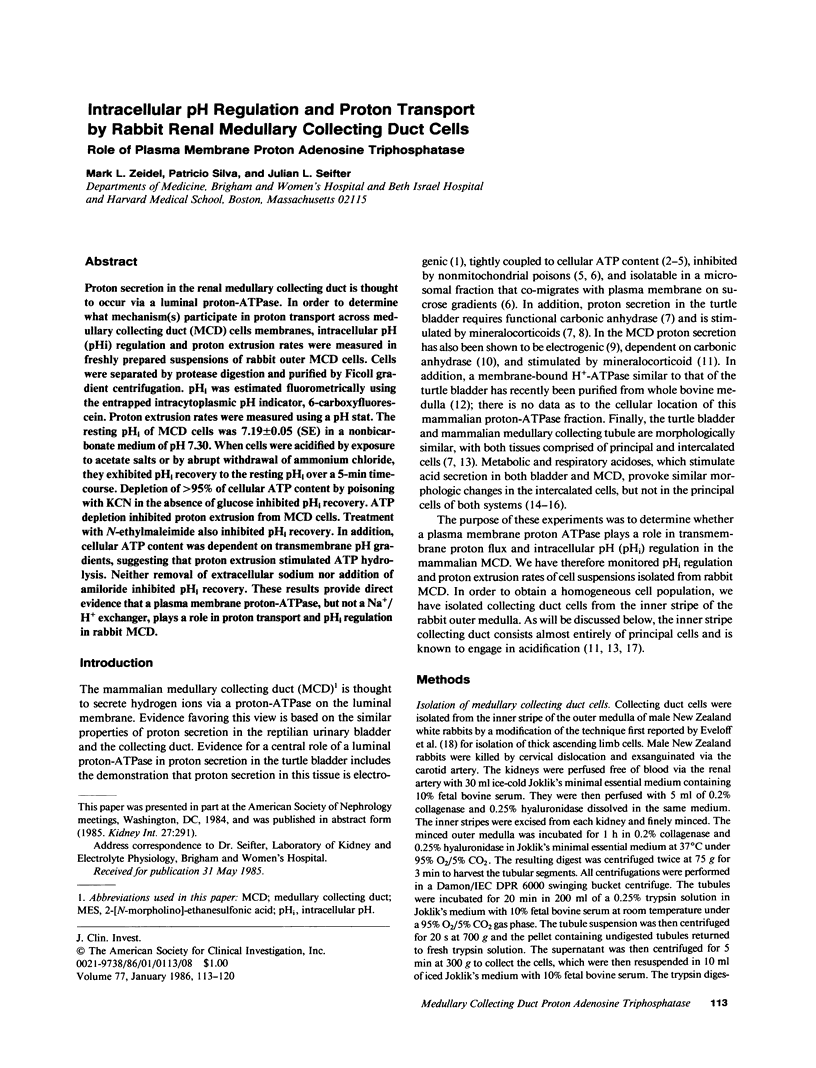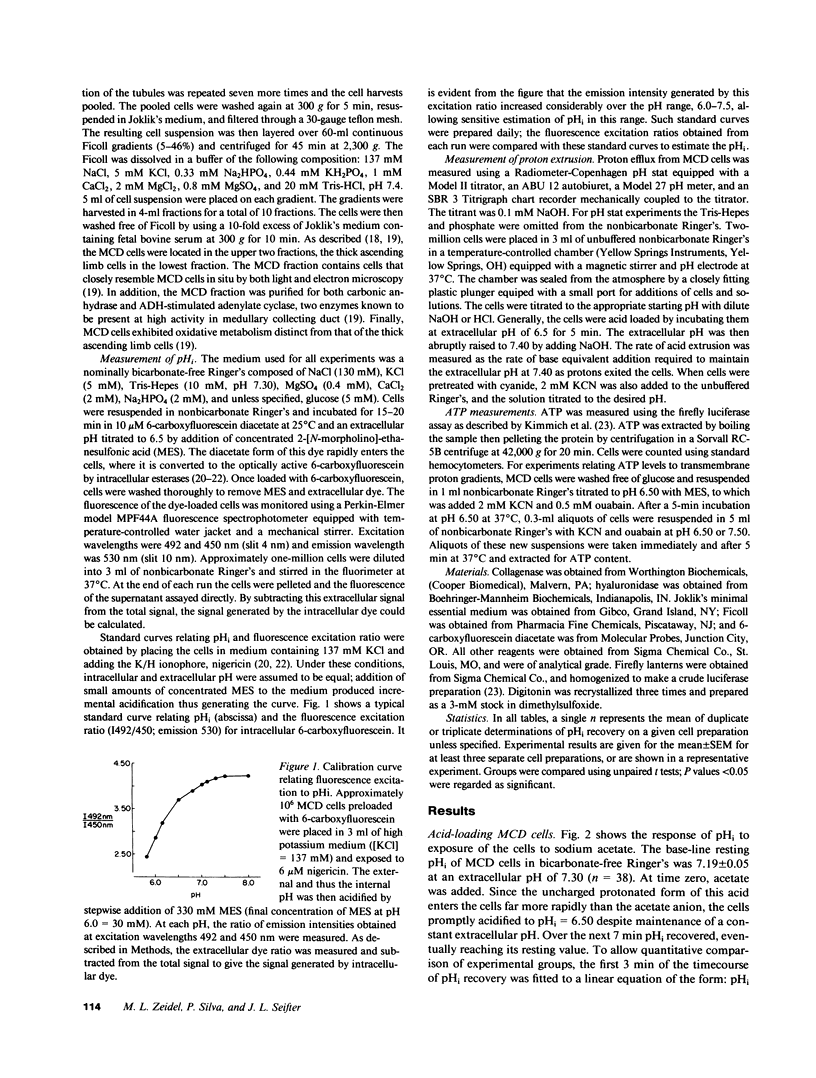Abstract
Proton secretion in the renal medullary collecting duct is thought to occur via a luminal proton-ATPase. In order to determine what mechanism(s) participate in proton transport across medullary collecting duct (MCD) cells membranes, intracellular pH (pHi) regulation and proton extrusion rates were measured in freshly prepared suspensions of rabbit outer MCD cells. Cells were separated by protease digestion and purified by Ficoll gradient centrifugation. pHi was estimated fluorometrically using the entrapped intracytoplasmic pH indicator, 6-carboxyfluorescein. Proton extrusion rates were measured using a pH stat. The resting pHi of MCD cells was 7.19 +/- 0.05 (SE) in a nonbicarbonate medium of pH 7.30. When cells were acidified by exposure to acetate salts or by abrupt withdrawal of ammonium chloride, they exhibited pHi recovery to the resting pHi over a 5-min time-course. Depletion of greater than 95% of cellular ATP content by poisoning with KCN in the absence of glucose inhibited pHi recovery. ATP depletion inhibited proton extrusion from MCD cells. Treatment with N-ethylmaleimide also inhibited pHi recovery. In addition, cellular ATP content was dependent on transmembrane pH gradients, suggesting that proton extrusion stimulated ATP hydrolysis. Neither removal of extracellular sodium nor addition of amiloride inhibited pHi recovery. These results provide direct evidence that a plasma membrane proton-ATPase, but not a Na+/H+ exchanger, plays a role in proton transport and pHi regulation in rabbit MCD.
Full text
PDF







Selected References
These references are in PubMed. This may not be the complete list of references from this article.
- Al-awqati Q., Mueller A., Steinmetz P. R. Transport of H+ against electrochemical gradients in turtle urinary bladder. Am J Physiol. 1977 Dec;233(6):F502–F508. doi: 10.1152/ajprenal.1977.233.6.F502. [DOI] [PubMed] [Google Scholar]
- Babcock D. F. Examination of the intracellular ionic environment and of ionophore action by null point measurements employing the fluorescein chromophore. J Biol Chem. 1983 May 25;258(10):6380–6389. [PubMed] [Google Scholar]
- Beauwens R., Al-Awqati Q. Active H+ transport in the turtle urinary bladder. Coupling of transport to glucose oxidation. J Gen Physiol. 1976 Oct;68(4):421–439. doi: 10.1085/jgp.68.4.421. [DOI] [PMC free article] [PubMed] [Google Scholar]
- Benos D. J. Amiloride: a molecular probe of sodium transport in tissues and cells. Am J Physiol. 1982 Mar;242(3):C131–C145. doi: 10.1152/ajpcell.1982.242.3.C131. [DOI] [PubMed] [Google Scholar]
- Boron W. F., De Weer P. Intracellular pH transients in squid giant axons caused by CO2, NH3, and metabolic inhibitors. J Gen Physiol. 1976 Jan;67(1):91–112. doi: 10.1085/jgp.67.1.91. [DOI] [PMC free article] [PubMed] [Google Scholar]
- Bowen J. W., Levinson C. H+ transport and the regulation of intracellular pH in Ehrlich ascites tumor cells. J Membr Biol. 1984;79(1):7–18. doi: 10.1007/BF01868522. [DOI] [PubMed] [Google Scholar]
- Busa W. B., Nuccitelli R. Metabolic regulation via intracellular pH. Am J Physiol. 1984 Apr;246(4 Pt 2):R409–R438. doi: 10.1152/ajpregu.1984.246.4.R409. [DOI] [PubMed] [Google Scholar]
- Dixon T. E., Al-Awqati Q. H+/ATP stoichiometry of proton pump of turtle urinary bladder. J Biol Chem. 1980 Apr 25;255(8):3237–3239. [PubMed] [Google Scholar]
- Dixon T. E., Al-Awqati Q. Urinary acidification in turtle bladder is due to a reversible proton-translocating ATPase. Proc Natl Acad Sci U S A. 1979 Jul;76(7):3135–3138. doi: 10.1073/pnas.76.7.3135. [DOI] [PMC free article] [PubMed] [Google Scholar]
- Dobyan D. C., Magill L. S., Friedman P. A., Hebert S. C., Bulger R. E. Carbonic anhydrase histochemistry in rabbit and mouse kidneys. Anat Rec. 1982 Nov;204(3):185–197. doi: 10.1002/ar.1092040303. [DOI] [PubMed] [Google Scholar]
- Eveloff J., Haase W., Kinne R. Separation of renal medullary cells: isolation of cells from the thick ascending limb of Henle's loop. J Cell Biol. 1980 Dec;87(3 Pt 1):672–681. doi: 10.1083/jcb.87.3.672. [DOI] [PMC free article] [PubMed] [Google Scholar]
- Gluck S., Al-Awqati Q. An electrogenic proton-translocating adenosine triphosphatase from bovine kidney medulla. J Clin Invest. 1984 Jun;73(6):1704–1710. doi: 10.1172/JCI111378. [DOI] [PMC free article] [PubMed] [Google Scholar]
- Gluck S., Kelly S., Al-Awqati Q. The proton translocating ATPase responsible for urinary acidification. J Biol Chem. 1982 Aug 25;257(16):9230–9233. [PubMed] [Google Scholar]
- Graber M. L., Bengele H. H., Schwartz J. H., Alexander E. A. pH and PCO2 profiles of the rat inner medullary collecting duct. Am J Physiol. 1981 Dec;241(6):F659–F668. doi: 10.1152/ajprenal.1981.241.6.F659. [DOI] [PubMed] [Google Scholar]
- Grinstein S., Rothstein A., Sarkadi B., Gelfand E. W. Responses of lymphocytes to anisotonic media: volume-regulating behavior. Am J Physiol. 1984 Mar;246(3 Pt 1):C204–C215. doi: 10.1152/ajpcell.1984.246.3.C204. [DOI] [PubMed] [Google Scholar]
- Guder W. G., Ross B. D. Enzyme distribution along the nephron. Kidney Int. 1984 Aug;26(2):101–111. doi: 10.1038/ki.1984.143. [DOI] [PubMed] [Google Scholar]
- Ives H. E., Rector F. C., Jr Proton transport and cell function. J Clin Invest. 1984 Feb;73(2):285–290. doi: 10.1172/JCI111212. [DOI] [PMC free article] [PubMed] [Google Scholar]
- Kaissling B., Kriz W. Structural analysis of the rabbit kidney. Adv Anat Embryol Cell Biol. 1979;56:1–123. doi: 10.1007/978-3-642-67147-0. [DOI] [PubMed] [Google Scholar]
- Kimmich G. A., Randles J., Brand J. S. Assay of picomole amounts of ATP, ADP, and AMP using the luciferase enzyme system. Anal Biochem. 1975 Nov;69(1):187–206. doi: 10.1016/0003-2697(75)90580-1. [DOI] [PubMed] [Google Scholar]
- Koeppen B. M. Conductive properties of the rabbit outer medullary collecting duct: inner stripe. Am J Physiol. 1985 Apr;248(4 Pt 2):F500–F506. doi: 10.1152/ajprenal.1985.248.4.F500. [DOI] [PubMed] [Google Scholar]
- Laski M. E., Kurtzman N. A. Characterization of acidification in the cortical and medullary collecting tubule of the rabbit. J Clin Invest. 1983 Dec;72(6):2050–2059. doi: 10.1172/JCI111170. [DOI] [PMC free article] [PubMed] [Google Scholar]
- LeFevre M. E. Effects of aldosterone on the isolated substrate-depleted turtle bladder. Am J Physiol. 1973 Nov;225(5):1252–1256. doi: 10.1152/ajplegacy.1973.225.5.1252. [DOI] [PubMed] [Google Scholar]
- Lombard W. E., Kokko J. P., Jacobson H. R. Bicarbonate transport in cortical and outer medullary collecting tubules. Am J Physiol. 1983 Mar;244(3):F289–F296. doi: 10.1152/ajprenal.1983.244.3.F289. [DOI] [PubMed] [Google Scholar]
- Madsen K. M., Tisher C. C. Cellular response to acute respiratory acidosis in rat medullary collecting duct. Am J Physiol. 1983 Dec;245(6):F670–F679. doi: 10.1152/ajprenal.1983.245.6.F670. [DOI] [PubMed] [Google Scholar]
- Madsen K. M., Tisher C. C. Response of intercalated cells of rat outer medullary collecting duct to chronic metabolic acidosis. Lab Invest. 1984 Sep;51(3):268–276. [PubMed] [Google Scholar]
- O'Neil R. G., Sansom S. C. Electrophysiological properties of cellular and paracellular conductive pathways of the rabbit cortical collecting duct. J Membr Biol. 1984;82(3):281–295. doi: 10.1007/BF01871637. [DOI] [PubMed] [Google Scholar]
- Pollock A. S. Intracellular pH of hepatocytes in primary monolayer culture. Am J Physiol. 1984 May;246(5 Pt 2):F738–F744. doi: 10.1152/ajprenal.1984.246.5.F738. [DOI] [PubMed] [Google Scholar]
- Roos A., Boron W. F. Intracellular pH. Physiol Rev. 1981 Apr;61(2):296–434. doi: 10.1152/physrev.1981.61.2.296. [DOI] [PubMed] [Google Scholar]
- Steinmetz P. R. Cellular mechanisms of urinary acidification. Physiol Rev. 1974 Oct;54(4):890–956. doi: 10.1152/physrev.1974.54.4.890. [DOI] [PubMed] [Google Scholar]
- Steinmetz P. R., Husted R. F., Mueller A., Beauwens R. Coupling between H+ transport and anaerobic glycolysis in turtle urinary bladder: effect of inhibitors of H+ ATPase. J Membr Biol. 1981 Mar 15;59(1):27–34. doi: 10.1007/BF01870818. [DOI] [PubMed] [Google Scholar]
- Stokes J. B. Ion transport by the cortical and outer medullary collecting tubule. Kidney Int. 1982 Nov;22(5):473–484. doi: 10.1038/ki.1982.200. [DOI] [PubMed] [Google Scholar]
- Stone D. K., Seldin D. W., Kokko J. P., Jacobson H. R. Anion dependence of rabbit medullary collecting duct acidification. J Clin Invest. 1983 May;71(5):1505–1508. doi: 10.1172/JCI110905. [DOI] [PMC free article] [PubMed] [Google Scholar]
- Stone D. K., Xie X. S., Racker E. An ATP-driven proton pump in clathrin-coated vesicles. J Biol Chem. 1983 Apr 10;258(7):4059–4062. [PubMed] [Google Scholar]
- Thomas J. A., Buchsbaum R. N., Zimniak A., Racker E. Intracellular pH measurements in Ehrlich ascites tumor cells utilizing spectroscopic probes generated in situ. Biochemistry. 1979 May 29;18(11):2210–2218. doi: 10.1021/bi00578a012. [DOI] [PubMed] [Google Scholar]
- Ullrich K. J., Papavassiliou F. Bicarbonate reabsorption in the papillary collecting duct of rats. Pflugers Arch. 1981 Mar;389(3):271–275. doi: 10.1007/BF00584789. [DOI] [PubMed] [Google Scholar]


